Serengeti National Park is found in the Republic of Tanzania and covers an area of about 5,700 square miles. The Serengeti lies in the northwestern part of the country continues to Kenya in what is referred to as the Maasai Mara National Reserve. It is the oldest national park in Tanzania and is what draws most tourists to the country. The Serengeti National Park is part of the so called Northern safari circuit which also includes Arusha National Park, Lake Manyara National Park, Ngorongoro Conservation Area and Tarangire National Park.
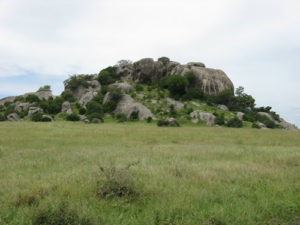 The name Serengeti is got from the Maasai word Siringet (meaning a place where land stretches forever). The Masai lived in the Serengeti plains for over 200 years before the first European explorer Oscar Baumann arrived in the area in 1892. At that time, the Serengeti had arguably the largest number of big game in Africa and because of that attracted sport hunters from both Europe and the United States. It was uncontrolled hunting of lions that forced the British colonial administration to turn it into a partial game reserve in 1921. By 1929 it had become a full reserve. This paved way for the eventual establishment of the Serengeti National Reserve 1951. By this time the Ngorongoro Conservation area was also part of the Serengeti. Later in 1959, the Ngorongoro Conservation area became a separate reserve.
The name Serengeti is got from the Maasai word Siringet (meaning a place where land stretches forever). The Masai lived in the Serengeti plains for over 200 years before the first European explorer Oscar Baumann arrived in the area in 1892. At that time, the Serengeti had arguably the largest number of big game in Africa and because of that attracted sport hunters from both Europe and the United States. It was uncontrolled hunting of lions that forced the British colonial administration to turn it into a partial game reserve in 1921. By 1929 it had become a full reserve. This paved way for the eventual establishment of the Serengeti National Reserve 1951. By this time the Ngorongoro Conservation area was also part of the Serengeti. Later in 1959, the Ngorongoro Conservation area became a separate reserve.
The Serengeti National Park is divided into three main sectors or regions – The Serengeti plains, Western Corridor and Northern Serengeti. The Serengeti plains is the most famous sector of the park and consists of endless grassland which are only interrupted by rocky hills (Kopjes) with vegetation. It is where most of the hoofed animals like wildebeest breed and feed from. Predators like lions, pythons and hyrax use the Kopjes to hide or observe grazing prey. The western corridor on the other hand consists of rivers and forest. It is where you find martial eagles, crocodiles, hippos and patas monkeys. The Northern Serengeti is dominated by hills and open woodlands. It is the best place to see giraffe, dik and elephants. It is very close to the Maasai Mara National Reserve and is where migrating wildebeest pass through when crossing to Kenya. You might be interested in an article about the top attractions on the Ngorongoro Crater. We also have an article about hiking Mount Kilimanjaro. Those who wish to visit the Seengeti but have a few days to spare should check out our 2 days Serengeti National Park safari package.
Wildlife in the Serengeti National Park
The Serengeti National Park is known around the world for its amazing biodiversity and abundant wildlife. The park is listed by UNESCO as a World Heritage Site. To protect the Eco-system in the park further, it has also been designated as a Category II protected area by IUCN. Each year over 1.5 million 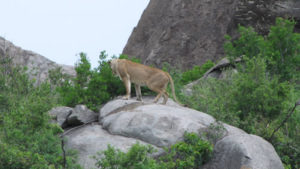 wildebeest, 300,000 gazelles and 200,000 zebras migrate in different sections of the park and then to the Masai Maara National Reserve. This phenomenon is described as one of the 10 natural wonders of the world and attracts thousands of tourists to the park each year. The Serengeti is also home to other grazers like the topi, hippos, warthogs, hartebeest, waterbucks, giraffes, impala, eland, bushbucks, klipspringer, lesser kudus, roan antelopes, dik dik and Oryx. Although the migrating grazers are a key attraction, it is the big 5 (Lions, Leopards, Elephants, Rhinos and Buffaloes) that brings tourists to the park throughout the year. The Serengeti is home to the largest population of lions in Africa – over 2,500 individuals. The cats thrive in the park mainly because of an abundance of prey. About 1,000 leopards call the park home while 5,000 elephants can be sighted in the park. Less than 50 black rhinos roam the Serengeti plains and this is because of uncontrolled poaching which occurred during the 1970’s and 80’s. Whereas rhinos are few, the Serengeti has over 53,000 buffaloes roaming the park.
wildebeest, 300,000 gazelles and 200,000 zebras migrate in different sections of the park and then to the Masai Maara National Reserve. This phenomenon is described as one of the 10 natural wonders of the world and attracts thousands of tourists to the park each year. The Serengeti is also home to other grazers like the topi, hippos, warthogs, hartebeest, waterbucks, giraffes, impala, eland, bushbucks, klipspringer, lesser kudus, roan antelopes, dik dik and Oryx. Although the migrating grazers are a key attraction, it is the big 5 (Lions, Leopards, Elephants, Rhinos and Buffaloes) that brings tourists to the park throughout the year. The Serengeti is home to the largest population of lions in Africa – over 2,500 individuals. The cats thrive in the park mainly because of an abundance of prey. About 1,000 leopards call the park home while 5,000 elephants can be sighted in the park. Less than 50 black rhinos roam the Serengeti plains and this is because of uncontrolled poaching which occurred during the 1970’s and 80’s. Whereas rhinos are few, the Serengeti has over 53,000 buffaloes roaming the park.
Apart from the already mentioned herbivores and big 5, the Serengeti is also home to cheetahs, hyenas, serval cats, jackals, wild dogs, otters, honey badgers, mongoose and the African golden wolf. There are also hyraxes, ground pangolin, crested porcupine, cape hare, bat-eared fox, aardwolf and aardvark. The primates in the park include baboons, vervet monkeys, black and white colobus monkeys. The primates are mostly concentrated in the forests close to Grumeti River.
What about birds and reptiles? When it comes to reptiles, the Serengeti is home to the serrated hinged terrapin, rainbow agama, puff adder, Nile monitor, Nile crocodile, leopard tortoise, chameleons, black-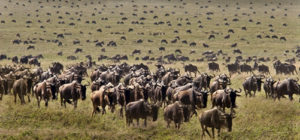 necked spitting cobra, black mamba and African python. Over 500 species of birds call the Serengeti National Park home and these include yellow-billed stork, vultures, southern ground hornbill, secretary birds, oxpeckers, Masai ostrich, martial eagles, marabou storks, lovebirds, lesser flamingo, kori bustards, helmeted Guinea fowls, Grey-breasted spur fowl and crowned cranes just to mention a few. Most of these creatures can be seen if you select our 3 days Serengeti safari package. We also have an amazing 6 days Rwanda gorilla trekking and Serengeti tour package.
necked spitting cobra, black mamba and African python. Over 500 species of birds call the Serengeti National Park home and these include yellow-billed stork, vultures, southern ground hornbill, secretary birds, oxpeckers, Masai ostrich, martial eagles, marabou storks, lovebirds, lesser flamingo, kori bustards, helmeted Guinea fowls, Grey-breasted spur fowl and crowned cranes just to mention a few. Most of these creatures can be seen if you select our 3 days Serengeti safari package. We also have an amazing 6 days Rwanda gorilla trekking and Serengeti tour package.
Tourism in the Serengeti National Park
The Serengeti is a wildlife haven for anyone planning on an African safari. Tourism brings over 100,000 international travelers to the park each year. The money collected from tourism is important in supporting wildlife conservation efforts, communities living near the park, research and other projects in the national park. The key attractions in the Serengeti National Park are day game drives, night game drives, balloon safaris over the vast plains, visiting the Seronera River Valley, walking safaris, following the great migration, birding, visiting the Serengeti Visitor Center, visiting the Bologonja Springs, visiting the Olduvai Gorge, exploring the Masai Cultural Villages and exploring the Kopjes (Large rocks with vegetation and where the predator love to hide).
The day game drives are designed purposely to allow visitors spot the big 5 mammals. This requires a 4X4 tour van because it involves driving for a long time and deep in the park. Game drives are done in the morning, afternoon and at night. The night game drives are designed to allow visitors spot nocturnal creatures (skinks, nightjars, crub hare, civets, chameleons, bush babies, bat-eared fox and aardvarks just 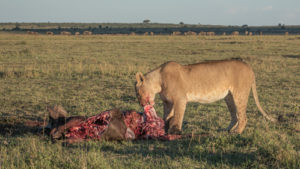 to mention a few) The game drives go all the way up to the famous hippo pool and to the Ngorongoro crater. Night game drives are also excellent for watching the endless battles between predator and prey. Similar to the game drives is watching the great migration. Unlike normal game drives that go on throughout the year, witnessing the wildebeest migration depends on the particular month of the year. It is also important to mention that one can view the big 5 and the migration from the sky using hot air balloons. An aerial view of the vast wilderness and Kopjes (giant rock formations with grass that look like islands) will give you a completely different perspective of the park. If Balloon safaris are not your thing, you can instead choose to view wildlife on foot.
to mention a few) The game drives go all the way up to the famous hippo pool and to the Ngorongoro crater. Night game drives are also excellent for watching the endless battles between predator and prey. Similar to the game drives is watching the great migration. Unlike normal game drives that go on throughout the year, witnessing the wildebeest migration depends on the particular month of the year. It is also important to mention that one can view the big 5 and the migration from the sky using hot air balloons. An aerial view of the vast wilderness and Kopjes (giant rock formations with grass that look like islands) will give you a completely different perspective of the park. If Balloon safaris are not your thing, you can instead choose to view wildlife on foot.
The Serengeti National Park is excellent for birding. Birders should expect to spot over 500 species of both resident and migratory birds if they have the time. The birds to watch out for are the Malachite Kingfisher, Nubian Woodpecker, Red-and-Yellow Barbet and the Grey Crowned Crane.
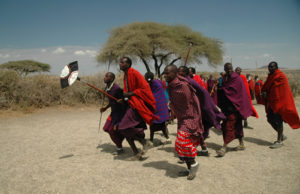 Apart from the wildlife, there is also the possibility of going for an amazing cultural experience in Tanzania with the Maasai Tribe in their villages. On a typical visit, the Maasai will take you to their homestead (known as bomas) to learn about their nomadic way of life, traditional dress code, marriage ceremonies, education system and their ancient tradition of keeping domestic animals. Visiting the Maasai is incomplete without taking part in the traditional Maasai dance and buying a few of their handicrafts.
Apart from the wildlife, there is also the possibility of going for an amazing cultural experience in Tanzania with the Maasai Tribe in their villages. On a typical visit, the Maasai will take you to their homestead (known as bomas) to learn about their nomadic way of life, traditional dress code, marriage ceremonies, education system and their ancient tradition of keeping domestic animals. Visiting the Maasai is incomplete without taking part in the traditional Maasai dance and buying a few of their handicrafts.
Between the Serengeti National Park and the Ngorongoro Crater is Olduvai Gorge. It is where the Leaky family discovered over sixty human fossils dating back to over two million years ago. Olduvai Gorge is one of the leading paleoanthropological sites in the world. There is a small Olduvai Museum containing artifacts and information about all the fossils that were discovered including the Laetoli footprints.
When leaving the park, do not forget to visit the Serengeti Visitor Center. You can take a walk around the center to learn more about the park, its history, the ecosystem and wildlife. The Center has beautiful gardens and is excellent for relaxation or picnics. If you are wondering about where to buy the best souvenirs, then the Serengeti Visitor Center is the place to visit.
Additional Information about Serengeti National Park
The government body responsible for managing the Serengeti National Park is the Tanzania National Parks Authority with support from several wildlife conservation Agencies. If you are organizing a safari on your own, you need to know that the entrance fee per day is $60 for adults $20 for children. Children under 5 years enter for free. If you are booking your trip through a tour operator, expect to have the park entrance fee included in the overall park fee.
When is the best time to visit Serengeti National Park? The best time to visit the Serengeti depends on what activities you are looking at and the section of the park you would be visiting. The best time for 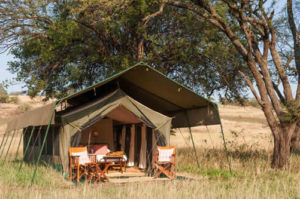 game drives is between June to October. These months find the park dry and with sparse vegetation hence allowing for better wildlife viewing. The best time to see the great migration is from December to May while that of birding is between November to April.
game drives is between June to October. These months find the park dry and with sparse vegetation hence allowing for better wildlife viewing. The best time to see the great migration is from December to May while that of birding is between November to April.
If you are wondering where to stay while on a safari in the Serengeti National Park, then you don’t need worry. There are several luxury, mid-range and budget hotels found within and outside the park. These accommodation facilities come in form of permanent tented camps, lodges, farms, mobile camps and campsites.
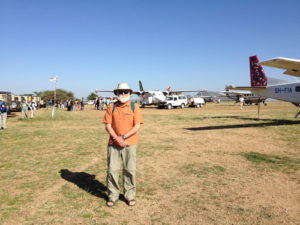 Serengeti National Park can be reached by air and road. The nearest airport and link to the park is Kilimanjaro international airport in Arusha. Air Burundi, Qatar Airways, Turkish Airways, Kenya Airways, Ethiopian Airlines, KLM and ZanAir all have flights to Kilimanjaro. From Kilimanjaro International Airport, one would need to book a smaller plane to one of the airstrips in the park or hire a car to go by road. The route by road starting from Arusha takes anywhere between 7 to 8 hours. Although the distance is long, travelers are rewarded with amazing scenery (communal farming lands, Olduvai Gorge, parts of Lake Manyara National Park, parts of the Ngorongoro crater and beautiful sights of the Rift Valley Escarpment).
Serengeti National Park can be reached by air and road. The nearest airport and link to the park is Kilimanjaro international airport in Arusha. Air Burundi, Qatar Airways, Turkish Airways, Kenya Airways, Ethiopian Airlines, KLM and ZanAir all have flights to Kilimanjaro. From Kilimanjaro International Airport, one would need to book a smaller plane to one of the airstrips in the park or hire a car to go by road. The route by road starting from Arusha takes anywhere between 7 to 8 hours. Although the distance is long, travelers are rewarded with amazing scenery (communal farming lands, Olduvai Gorge, parts of Lake Manyara National Park, parts of the Ngorongoro crater and beautiful sights of the Rift Valley Escarpment).

